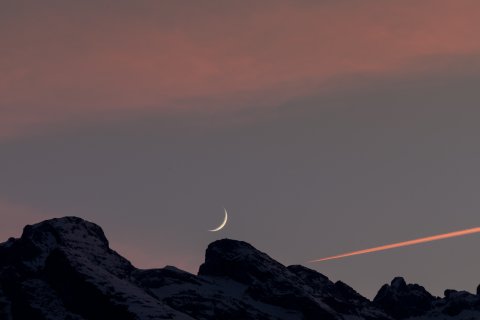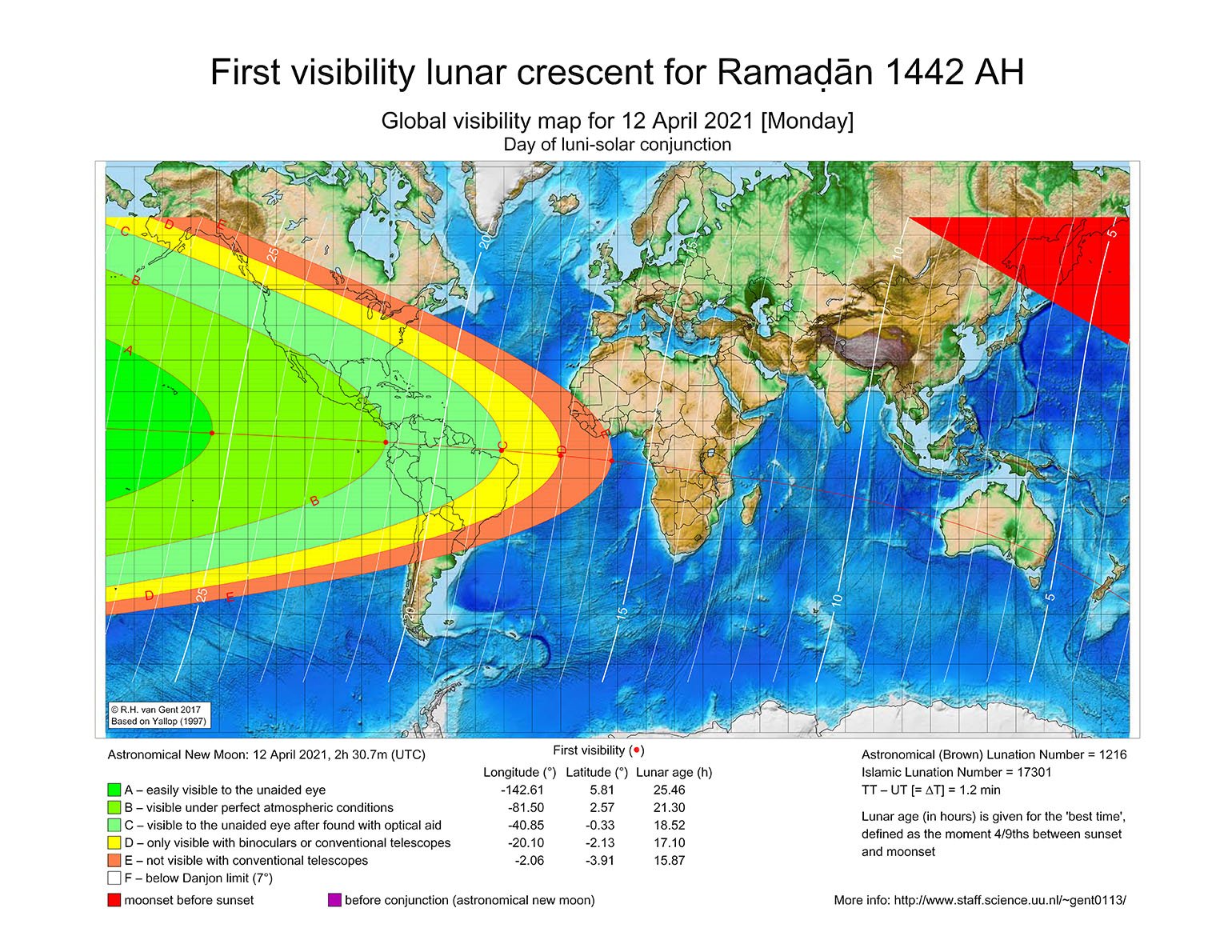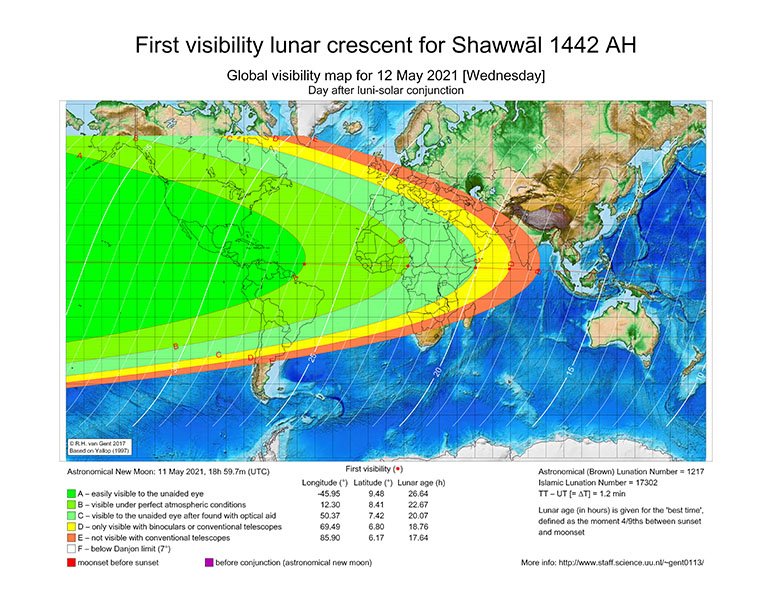Between tradition and science: when does Ramadan begin?
Ramadan starts this week. But when exactly? There is no consensus on this.
By Rob van Gent (Mathematical Institute), emeritus researcher on the history of astronomy, mathematics and scientific instruments
Ramadan, a period of about 30 days during which Muslims around the world fast from the beginning of the morning twilight until sunset, begins this week. The fast means that Muslims are not allowed to eat, drink or smoke during the day. The approach of Ramadan also marks the start of the annual discussion about when exactly Ramadan begins. At first sight, this seems like a simple question: Ramadan begins at the start of the month of the same name – the ninth month in the Islamic lunar calendar – and ends when the month ends. However, determining this is not so simple and often leads to much discussion and uncertainty every year.

Tradition
According to Islamic tradition, each day in the Islamic calendar begins at sunset and each month begins on the evening on which the narrow lunar crescent, just after the new moon, can be seen for the first time shortly after sunset low in the west with the naked eye. However, this is more difficult than it seems, as it requires a certain familiarity with celestial phenomena. Moreover, the visibility of the narrow lunar crescent strongly depends on where you are on the globe. And of course, local weather conditions play a crucial role: if it is cloudy, there is little to see.
Calculate or observe?
That is why many Muslim organisations use a calculated lunar calendar. However, depending on the calculation methods and approaches used, this may differ from a calendar based strictly on observations of the lunar crescent. In Western countries, where Muslims of various origins live, different lunar calendars are used, which often causes confusion. For example, Dutch Muslims follow no less than three different lunar calendars which sometimes differ by one or more days.
Practice in the Netherlands
Turkish Muslims follow a calculated lunar calendar, the Diyanet calendar, in which each month begins on the evening on which, according to astronomical calculations, the crescent moon could be seen somewhere on the globe. Muslims in the Far East, including Indonesia and Malaysia, follow a similar calculated lunar calendar. With these calendars, there is never any discussion about the correct date and the dates for the most important Muslim festivals can be determined years in advance.
Among Dutch-Moroccan Muslims, some follow a lunar calendar which is determined on the basis of the actual observation of the lunar crescent from Morocco. This means that they do not know for sure until the evening itself when Ramadan begins (and ends).
In addition, many Dutch-Moroccan Muslims follow the lunar calendar of Saudi Arabia. This Umm al-Qura calendar is a calculated lunar calendar, in which each month starts on the evening on which the moon, as seen theoretically from the Ka’aba in Mecca, sets later than the sun for the first time. However, the calculated starting dates of the months are usually one day earlier than those in a lunar calendar that is based on the actual visibility of the crescent moon from Mecca.
Therefore, religious authorities in Saudi Arabia check the calculated dates with the actual sighting of the crescent moon from the Arabian peninsula during the beginning (and the end) of Ramadan and the beginning of the month of pilgrimage (Dhu al-Hijjah), with which the dates of the hajj (annual pilgrimage) and the Feast of Sacrifice are determined. Remarkably, the announced first sighting of the lunar crescent from the Arabian peninsula often turns out to fall on an evening when, according to astronomical calculations, this is actually not possible at all.
The dates for 2021

Start Ramadan
According to astronomical calculations, the lunar crescent will be visible for the first time with the naked eye from Central America on the evening of Monday 12 April. (With optical aids, this should also be possible from the northern part of South America and the southern part of North America.) In most Muslim countries this will only be possible with the naked eye on the following evening, Tuesday 13 April. On that evening, the narrow lunar crescent should also be visible from the Netherlands without any problem.

End Ramadan
The lunar crescent that marks the end of Ramadan will be visible for the first time with the naked eye from the western part of Africa on Wednesday evening 12 May. (With optical aids this should also be possible from North Africa, Central Africa and the Iberian Peninsula.) In most Muslim countries to the east of this point, including the Netherlands, this will not be the case until the following evening, Thursday 13 May.
According to the Diyanet calendar and the Umm al-Qura calendar, Ramadan begins on the evening of Monday 12 April and ends on the evening of Wednesday 12 May.
More information
- Predicting the First Visibility of the Lunar Crescent – with world maps for the predicted visibility of the lunar crescent based on an astronomical algorithm published by British astronomer Bernard Yallop in 1997.
- The Islamic Calendar of Turkey – with a date converter valid between 1900 and 2027.
- The Umm al-Qura Calendar of Saudi Arabia – with a date converter valid between 1937 and 2077.
- Islamic-Western Calendar Converter – based on the arithmetic or tabular Islamic lunar calendar and therefore only suitable for approximate date conversions.

